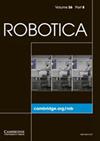基于八杆机构的新型被动辅助膝关节外骨骼机器人的生物融合设计与参数优化
IF 2.7
4区 计算机科学
Q3 ROBOTICS
引用次数: 0
摘要
为了缓解下肢行走时膝关节疲劳和损伤问题,研究了一种新型的人机交互被动辅助外骨骼机器人,以辅助人体膝关节的运动。外骨骼结构的设计考虑了膝关节的生理结构和步态功能,确保满足膝关节运动、受力和步态功能的要求。为了探索穿戴者与外骨骼之间的相互作用,建立了穿戴外骨骼后的人机运动学模型,这有助于分析穿戴者与外骨骼的整合运动。此外,还利用牛顿-欧拉法和力多边形法分别建立了穿戴外骨骼后膝关节的动态和静态模型,以评估外骨骼的有效性。此外,还利用人体运动学模型和力学模型优化了外骨骼的尺寸参数和弹簧刚度。此外,还通过使用 OpenSim 进行人体仿真,评估了外骨骼在证明辅助功能方面的有效性。结果表明,外骨骼可将膝关节扭矩大幅降低 48.42%。本文章由计算机程序翻译,如有差异,请以英文原文为准。
Biofusion design and parameter optimization for a novel passive assisted knee exoskeleton robot based on eight-bar mechanism
In an effort to alleviate the issue of knee joint fatigue and injury during lower limb ambulation, a novel passive assisted exoskeleton robot with human–machine interaction is investigated to assist the movement of the human knee joint. The design of the exoskeleton configuration takes into consideration the physiological structure and gait function of the knee joint, ensuring that it satisfies the requirements for motion, force, and gait function of the knee joint. To explore the interaction between the wearer and the exoskeleton, a human–machine kinematic model after wearing exoskeleton is established, which is instrumental in analyzing the integration motion of the wearer and exoskeleton. In addition, the dynamic and static models of the knee joint after wearing the exoskeleton are established, utilizing the Newton–Euler method and force polygon method, respectively, to evaluate the effectiveness of the exoskeleton. Moreover, the size parameters and spring stiffness of the exoskeleton are optimized, using both human body kinematic model and mechanic model. Furthermore, the effectiveness of the exoskeleton in proving assistance is evaluated through human body simulation, using OpenSim. The results indicate that the exoskeleton significantly reduces the knee joint torque by 48.42%.
求助全文
通过发布文献求助,成功后即可免费获取论文全文。
去求助
来源期刊

Robotica
工程技术-机器人学
CiteScore
4.50
自引率
22.20%
发文量
181
审稿时长
9.9 months
期刊介绍:
Robotica is a forum for the multidisciplinary subject of robotics and encourages developments, applications and research in this important field of automation and robotics with regard to industry, health, education and economic and social aspects of relevance. Coverage includes activities in hostile environments, applications in the service and manufacturing industries, biological robotics, dynamics and kinematics involved in robot design and uses, on-line robots, robot task planning, rehabilitation robotics, sensory perception, software in the widest sense, particularly in respect of programming languages and links with CAD/CAM systems, telerobotics and various other areas. In addition, interest is focused on various Artificial Intelligence topics of theoretical and practical interest.
 求助内容:
求助内容: 应助结果提醒方式:
应助结果提醒方式:


